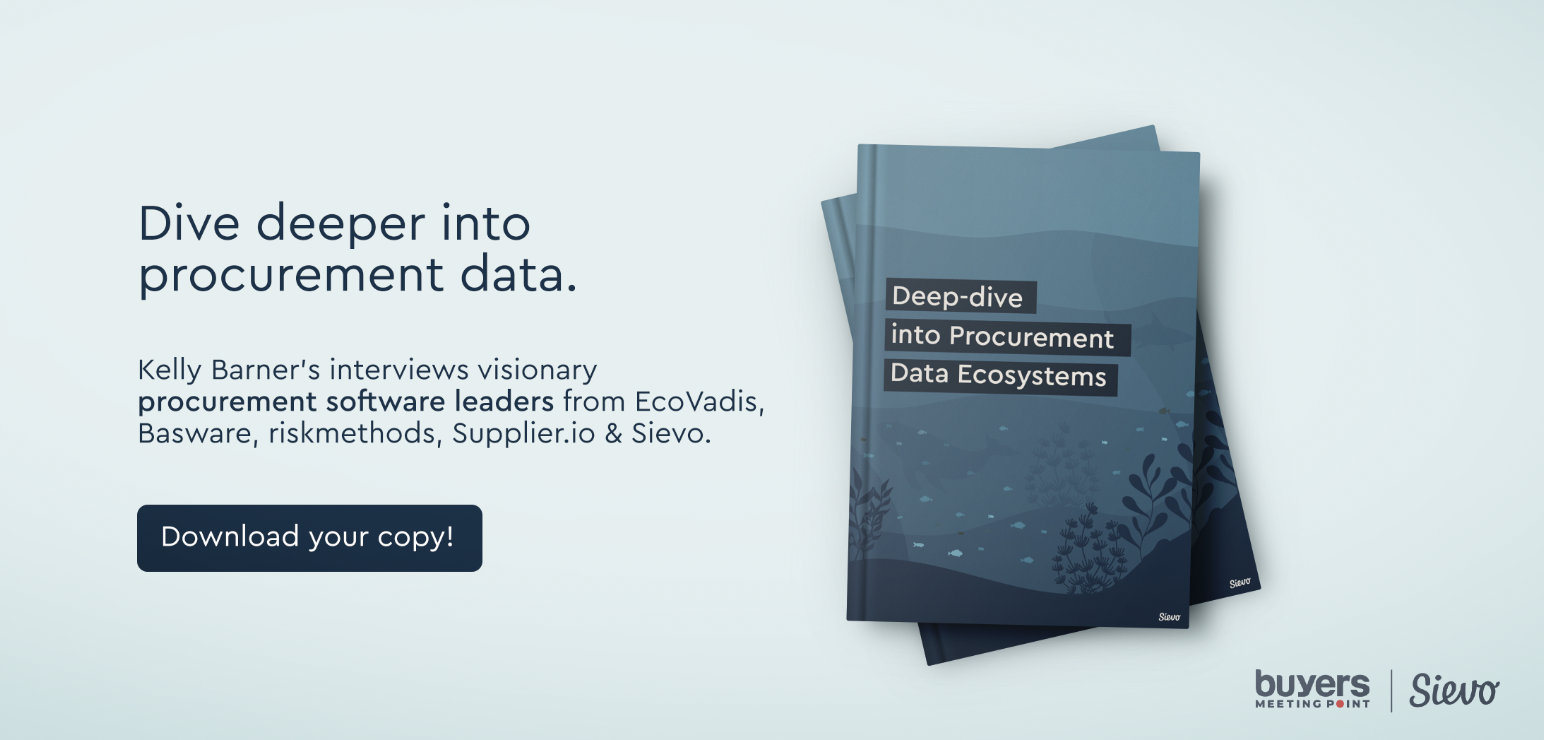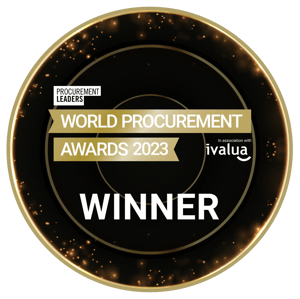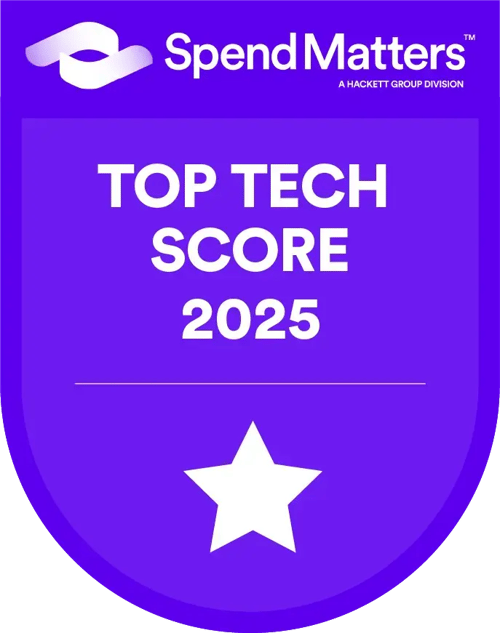
Thought Leadership
Beyond the Hype – Fostering a Healthy Procurement Data Ecosystem

Kelly Barner • Mar 3, 2021

Procurement is rapidly evolving into a strategic function entirely powered by data-derived insights. Access to high quality, actionable data determines not only how valuable procurement is to corporate profitability, but also the extent to which they can measurably contribute to increased market share and competitive advantage.
In this article, Sammeli Sammalkorpi, CEO and co-founder of Sievo, provides us with insight into what he has learned - through real-life experiences – about how to build a thriving procurement data ecosystem.
The Basis of the Ecosystem - Reef Building Corals
Procurement data systems and oceans have surprisingly much in common. Both can be expansive, complex and full of opportunity. In the wrong hands they can also be vulnerable and turn dirty. When you think of building a healthy basis for managing your procurement data, think of it as an ocean that needs to be nurtured.
Reef building corals serve as the core of the ecosystem. Without a healthy coral reef, there is no basis for the larger ecosystem to prosper.
The equivalent of reef building corals in a thriving procurement data ecosystem is a company’s internal data: invoices, purchase orders, and master data captured from ERPs and financial and procurement systems. There are certain core practices a company needs to get right if they want to build the environment required to sustain a healthy core:
Start with spend – all spend. At the very core of your data ecosystem needs to be 100 % of the company’s spend. Not only is this spend a valuable data asset in its own right, but it also provides visibility into the suppliers used, materials and services purchased, and teams/business units doing the purchasing. It may not be perfect, in fact - it may be a bit dirty, but this is the best view of reality a company can have. In addition, the beauty of spend analysis is that it uses invoice lines to connect suppliers to categories, categories to buying organisations, and buying organisations to suppliers. These links between categories, suppliers, and buying organisations are THE key elements of the data ecosystem.
Go beyond spend. Spend is a great starting point, but procurement will need to capture other data sets to serve their varied analytics purposes: purchase orders to support operational risk management, goods receipts data to manage supplier performance, volume and price forecasts to understand future cost developments, etc. Just having one kind of coral is not enough for a thriving ecosystem. For this, procurement will need a diverse range of information sources.
Get your category structure right. Having a good standard category structure, one that reflects supplier markets, is essential for a healthy procurement data ecosystem. It is important to effectively classify purchased materials and services to that standard structure, not an easy task to be sure. Ideally, the aligned category structure and supplier markets would drive the organization of the procurement team, as there is an advantage to building procurement around critical supplier markets.
Regard suppliers as the key. While categories only exist in procurement’s imagination (and potentially their technology), suppliers and industries are real. These suppliers are where opportunities for cost reduction and innovation begin, and where procurement’s reputation and supply chain risks play out. Getting this right is essential.
Link procurement to the business in word and deed. Modern procurement does not work in isolation; it is an active business partner to multiple stakeholders. As a result, the procurement’s data ecosystem must not be driven by procurement’s view and lingo (categories, savings), but incorporate cross-functional stakeholder lingo (business unit, end products, P&L impact, PPV forecast, etc.).
Focus on data quality feedback loops, not on upfront data quality. Data has a quality unlike most commodities: the more you use it, the better it gets. The key to high data quality is NOT having perfect master data upfront. This is not an achievable goal, since external data is beyond procurement’s control. Invest in effective feedback loops instead. When analytics consumers see something wrong, he or she must be able to correct it or provide specific feedback on the spot.

External Data – There’s plenty of fish in the ocean
Not all species can, or should, be part of procurement’s data ecosystem. Each company will need to decide which species are so vital to their prosperity that they are willing to give something back in exchange.
Internal data has been available for a long time, but the number of available external data sources has exploded over the last few years. A number of new players have emerged to provide different types of data and insights on domains such as supply chain risk (riskmethods), diversity (Supplier.io), sustainability (EcoVadis), and market commodities (Mintec). We also have access to the internet, which provides an almost endless source of free data.
"Procurement should see themselves as the data interface between the company and the upstream ecosystem,” Sammalkorpi pointed out. I believe procurement should take a lead role in capturing all kinds of data regarding the external ecosystem.
Understanding the right type(s) of external data, and what needs to be done before this information can be put into use by procurement and/or the business, is just as critical to the success of the ecosystem as the foundational coral reef.
There’s no such thing as data that is free AND valuable. Free data (i.e., anything on internet) comes with a tremendously bad ‘signal-to-noise’ ratio. Making sense of this data is hard, and it is not feasible for any single procurement organisation to create tools and processes for capturing and processing this data on a scalable basis. Exceptions exist of course; a lot of commodity pricing data is nearly free, available in a well-structured format, and highly relevant for certain categories. In most cases, however, free access to a lot of data doesn’t translate into actionable insights.
Specialist data providers can make sense of data - at a price. Since sifting through vast amounts of data is not easy, a number of players have emerged to make sense of it. (Supplier.io, EcoVadis, and riskmethods are great examples.) Unsurprisingly and understandably, they want to be compensated fairly for the work they do and the value they bring. Procurement organizations need to make two critical decisions:
- Which data sets are worth paying for,
- Whether they want to cover all spend / all suppliers or focus on the categories and suppliers where enriched data sets provide additional value.
This is where the practical challenges of fostering a thriving ecosystem start.

A Healthy Ecosystem Requires Healthy Interspecies Interactions
A healthy ecosystem requires that the fish and the corals benefit from their involvement. The relationship has to be symbiotic and based on interactions between the species that give more benefits than they require energy.
The energy consumed in ecosystem interactions is often overlooked. The ‘sign up’ pitch is beautiful – there’s an API, and all that is required is to integrate to it to exchange information in real time. In practice, however, there are many challenges associated with getting such a model up to speed. For instance, in most cases, data sets are licensed on a per supplier basis.
This means that procurement usually needs to select which suppliers to enrich, unless they’ve got very deep pockets. The investment is not trivial, as it’s often not simply the biggest-spending suppliers that you want information on, but the most critical ones.
- In the case of supply chain risk, this would be single-source suppliers of critical components.
- For child labor issues, this would probably include suppliers located in (or having second tier suppliers in) certain geographical regions.
- For unexpected issues like the COVID-19 pandemic, priorities will shift at an amazing speed, requiring any number of additional suppliers to receive enrichment and monitoring.
To keep costs at a feasible level, procurement needs to be smart about which suppliers to enrich. Far from being a simple, one-off exercise, this requires ongoing management – a far more challenging proposition.
Even then, deciding which suppliers to enrich on continuous basis is just the start. The truth is that even the suppliers selected for enrichment will only have partial coverage. In certain cases, data providers don’t have information on the supplier(s) you are interested in. In other cases, they have the data, but vendor matching gets in the way (the classic “IBM,” “I.B.M.,” “International Business Machines” issue).
Many of these issues can be solved with intelligent matching processes (yes, AI is in play!), but there will always be residual non-matches. These exceptions will trigger processes around understanding why a match was not made, potentially enlarging their supplier coverage, etc. In short, what was supposed to be a completely automated API-based information exchange, turns into lot of manual back-and-worth between procurement and the enrichment partner. Suddenly, the energy required for interspecies interactions exceeds the benefits.
When designing an enrichment process, remember that the hard part is not when things go as planned. The hard parts are managing exceptions, maintaining the agility to change enrichment priorities over time, and keeping down enrichment costs (in the form of supplier fees and processing costs).
Conclusion… taking an ecosystem view
Looking at a coral reef overall is far more amazing than focusing in on any one component of it. Yes, there are some amazing, beautiful fish in the sea. Yes, corals come in many colors and shapes. However, it is the entirety of the coral reef that is more amazing than any specific specie.
Serving both specialist and generalist needs
Pretty much all specialist data providers also offer software functionality. These specialist tools are excellent for people who need and want to drill deep into the specifics of risk, sustainability, diversity, etc.
However, for the vast majority of users and use cases, no one of these topics exists in isolation. For example, understanding the risk level associated with “Supplier X” is relatively useless compared to the value of being able to answer, “Which critical components do I risk having supply shortages on due to Supplier X’s difficulties, and who are the alternative suppliers?” Understanding that you have 100 diverse suppliers is not really relevant; understanding how big a share of your spend/supplier base is made up by diverse suppliers is.
Capturing the true value of external data sets requires - almost paradoxically - that these data sets are primarily NOT analysed in purpose-built-tools from providers but combined with internal data for sense-making purposes. This is where we see that the ecosystem is more than the sum of its parts.
Combining internal with external data
External data sets are typically related to individual suppliers (supplier risk scores, supplier sustainability ratings, supplier diversity, etc.). While procurement’s analytical needs are sometimes driven by the supplier’s perspective, they are more often driven by a category, region, or business unit perspective – or some combination of them. To benefit from an external data set, procurement must find ways to combine it with internal data for context. This will demonstrate what share of the suppliers in category X are diverse, or which materials are at risk of being in short supply due to problems with supplier X.
To support such analysis, it is not enough to “link suppliers to categories” (for instance). One supplier may serve multiple categories, so working at the category-level prevents material-level insights. Such an approach does not provide any support for regional or business-specific analytics.
Luckily, with spend analysis, procurement has a powerful, scalable starting point. Well-constructed spend analysis links suppliers with categories, businesses, and regions at the transaction level. Spend analysis puts suppliers into perspective – how much spend, how often purchases occur, which categories are served, etc.
The key to leveraging external data is to make it part of the procurement data and analytics ecosystem. All external supplier information must become a natural extension of traditional spend analysis. This enables procurement to leverage external data, natively from the supplier perspective as well as by category, region, and for business-specific use cases.
When done correctly, procurement can combine the strengths of spend analysis and external data providers’ tools. Spend analysis is the place to see the big picture. If procurement wants to dig into the details of risk/diversity/sustainability/etc., clicking a link on spend analysis platform will take you the details of the domain.
In this way, we are able to appreciate the coral reef for its overall health and beauty while still recognizing the unique appeal of each fish and coral.
About Deep-dive into Procurement Data Ecosystems with Kelly Barner
This article series was written by Kelly Barner, top procurement influencer and owner of Buyers Meeting Point.
All companies require data in order to function, but in today’s hyper-connected world, large enterprises have specific additional needs around technology-enabled scalability and standardization that smaller organizations may be able to get by without or supplement with manual alternatives. These multi-faceted data challenges exist within and outside of their procurement operations.
In order to explore and articulate the multi-faceted data requirements of large enterprises, we reached out to several leading companies to gain unique insight into the criticality of linking internal data and third-party data via robust procurement analytics capabilities. The result is a thoughtful article series that explores fresh ways procurement leaders can turn data from a challenge to an opportunity.

Dive deeper into procurement data in the new guide featuring Kelly Barner’s interviews with visionary procurement software leaders from EcoVadis, Basware, riskmethods, Supplier.io and Sievo.
Open Positions
Welcome to explore our open job opportunities around the world
- Position
- Location
- Apply Before

